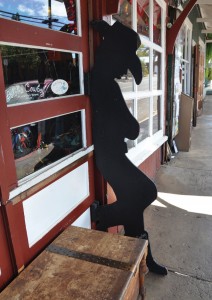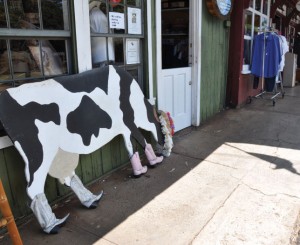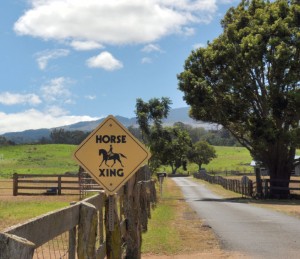Makawao
Maui’s Answer to the Wild, Wild West
Story by Morris Haole, Photography by Lois Whitney Bisquera
Located in what local residents term as upcountry, Makawao has long been identified with cattle raising and a cowboy mystic. As sugar cane and pineapple plantations developed at the lower elevations, the soft rolling hills at the 1,500 feet level provided rich grasses and extensive grazing ideal for beef production.
There are many colloquial phrases used today that pertain to the cowboy expe- rience that originated, like in the south- west, with the Spanish language. Hawaiian cowboys are referred to as ‘paniolo,’ an expression derived from the word ‘Espanol.’ In the early 19th century Capt. George Vancouver made a gift of cattle to Kamehameha I, but it was Kamehameha II who visited California, then still a part of Mexico, saw firsthand the skill of the Mexican cowboys and brought several back with him to manage Hawaii’s emerging cattle enterprises.
The native Hawaiians had no knowledge of cattle and were undoubtedly amazed by the gentle equine giants. However, over the years, through cultural exchanges ‘paniolo’ became a distinct lifestyle more than just an occupation. At one time with so much cattle being raised by both the large ranches and smaller concerns, Makawao boasted three packing houses and the county’s largest dairy, which boasted contented black and white Holsteins.
As a natural complement to the town’s livestock production, agriculture has become another source of economic sustainability. Thanks to an ideal climate of plentiful rain and moderate tempera- tures; harvesting is a year-round under- taking and yields an abundant selection of Grade A vegetables, prize-winning tropical fruit and exotic flowers that are world famous. Neighbors often engage in a friendly competition to see who can grow the largest banana bunch or the sweetest papaya, with the winner gladly giving away his produce coupled with advice and growing tips.
The town’s residents have all con- tributed to the bustling growth of Makawao. Besides the native Hawaiians, immigrants from Europe, the Philippines, Japan, China and America settled in and were employed in Maui’s celebrated large-scale plantations. They acquired land and helped create a unique culture through intermarriage and joining civic organizations.
 Driven by financial necessity and the novelty of a new land, Makawao’s new “children” opened businesses like bak- eries, general stores, bars, restaurants, butcher and barber shops and a the- ater, all constructed of wood resembling the quintessential ‘old western town.’ Houses of worship were also construct- ed, including one of Maui’s most beauti- ful churches: Saint Joseph, a classic French gothic designed church that became the center of the area’s large Portuguese population. The church fea- tures exquisite stained glass windows, a 70-foot bell tower and traditional church graveyard.
Driven by financial necessity and the novelty of a new land, Makawao’s new “children” opened businesses like bak- eries, general stores, bars, restaurants, butcher and barber shops and a the- ater, all constructed of wood resembling the quintessential ‘old western town.’ Houses of worship were also construct- ed, including one of Maui’s most beauti- ful churches: Saint Joseph, a classic French gothic designed church that became the center of the area’s large Portuguese population. The church fea- tures exquisite stained glass windows, a 70-foot bell tower and traditional church graveyard.
A similar occurrence took place with the Japanese community, which organized the Makawao Hongwanji Mission, a Buddhist school of thought committed to numerous civic activities. Close to the hearts of many is another sacred place of honor and sacrifice, the Makawao Veterans Cemetery, which is the final resting place of those who gave their lives for their country. On sunny afternoons, this cemetery becomes an informal meeting place for families and friends, whose home-grown blossoms transform the quiet green lawns into a parade of colors.
Within its rustic scenery, the rural areas surrounding Makawao conceal signifi- cant numbers of axis deer that forage at night, causing damage to fencing, farm crops and backyard gardens. The deer are a popular quarry for hunting as well as wild turkeys and feral pigs, thus many a local hunter cherishes his favorite ‘can’t fail’ wild game recipes. There are also ringneck pheasant, franklin, California quail and common grouse that thrive in the eucalyptus groves sur- rounding Makawao.
The name Makawao means “Beginning of the forest,” an appropriate name as the area was once thick with many native trees. The most important and useful of these was Acacia Koa, an invaluable hard wood used by the Hawaiian people for canoes, surf boards, implements and religious carvings. Today it is in demand
for costly furniture, art work and musical instruments.
Because of its unobtrusive charm, laid- back manner and beautiful vistas, Makawao has attracted a number of tal- ented artists. Dotting both sides of Baldwin Avenue are shops and galleries of artists who work in several types of art forms. There are innovative glaziers dis- playing masterpieces in glass, custom jewelers with one-of-a-kind items and photographers’ studios that feature remarkable prints, giclée and historical reproductions.
Some of the island’s best restaurants also are located in the heart of town; there is no shortage of good food served by friendly wait help who love visitors. One can choose from Italian, Mexican, and Japanese, contemporary and as a tribute to its cattle ranching legacy, an excellent steakhouse.
Makawao experienced the counter cul- ture movement in the late ‘60s and throughout the ‘70s with an influx of ‘hippie’ adherents; this flamboyant group sought individualism as an anti- dote to modern society and in the process reinvented themselves. Many grew out of their antisocial behavior and embraced small business proprietor- ship; today they complete the birth of a new Makawao by owning and operating new age holistic health clinics, aro- matherapy and herbal shops, as well as providing acupuncture for aches, pains and allergies.
Life is good in the historic town of Makawao- she is charming, provocative and bountiful, and those who visit are captured by the gifts she shares with all.
